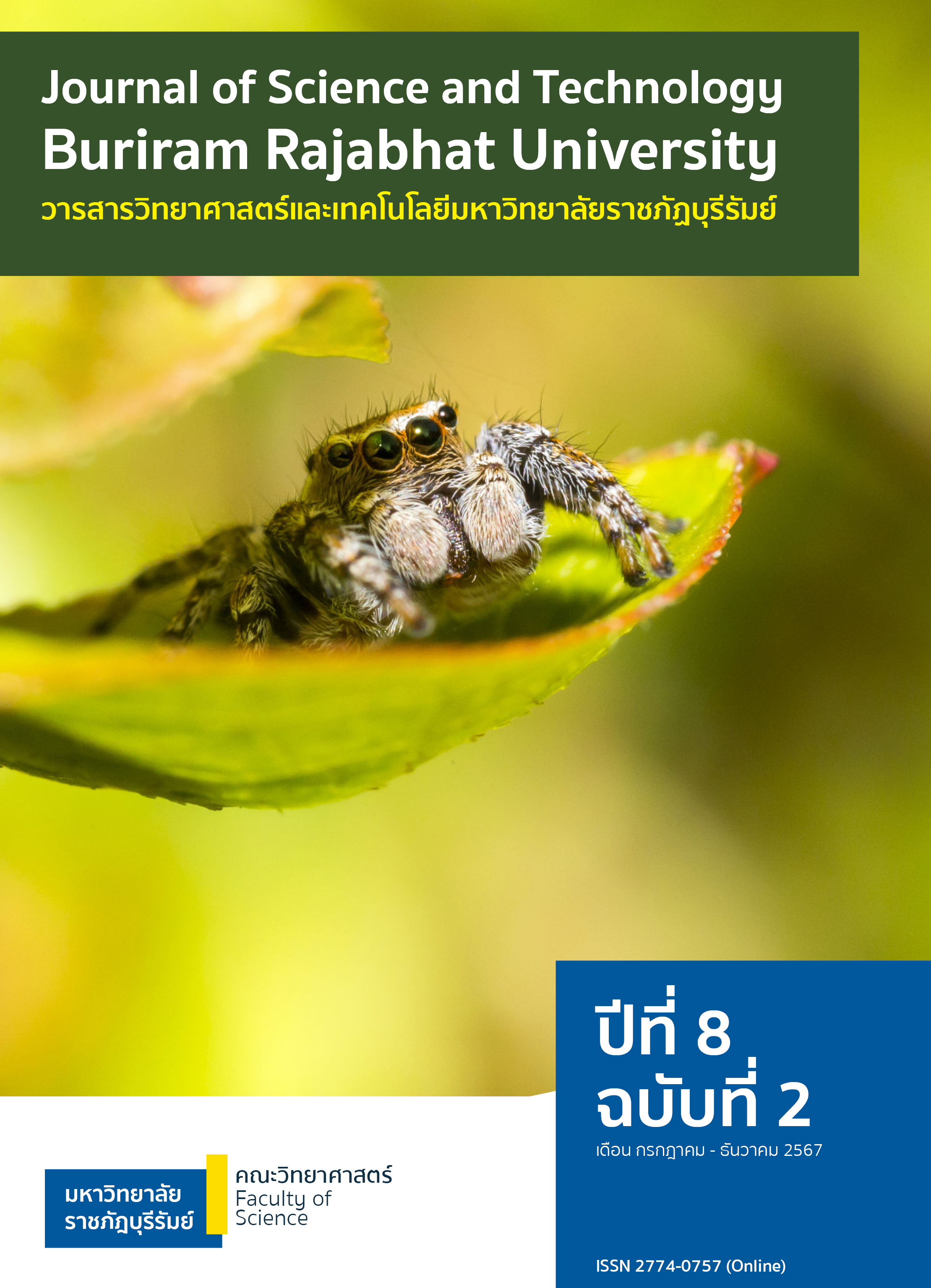การเพิ่มประสิทธิภาพอิเล็กโทรด SPCE ด้วยอนุภาคนาโนของทองคำและแพลทินัมเพื่อปรับปรุงการตรวจจับภาวะเครียดจากปฏิกิริยาออกซิเดชัน
Main Article Content
Abstract
This research focuses on the synthesis of gold and platinum nanoparticles to enhance SPCE electrodes for future application in detecting oxidative stress using cyclic voltammetry techniques. TEM analysis showed that the nanoparticles sizes of approximately 6.4 nm, while XRD results indicated diffraction peaks for gold and platinum nanoparticles at 2 theta angles of approximately 38.1°, 44.4°, 64.8°, 77.6°, and 81.8°, with the latter corresponding to platinum. Following synthesis, the nanoparticles were electroplated onto the SPCE electrodes using an KCl solution mixed with gold and platinum nanoparticles at applied voltages of -0.25V, -0.5V, -0.75V, and -1V. Raman spectroscopy revealed peaks at 1200-1450 cm-¹ and 1500-1600 cm-¹, indicating carbon, gold, and platinum overlaps. SEM analysis showed clear characteristics of the gold nanoparticles. Cyclic voltammetry tests on the electroplated electrodes indicated that the -0.25 V voltage provided the most significant signal enhancement compared to other voltages and untreated electrodes. This study concludes that the use of gold and platinum nanoparticles significantly improves the signal of SPCE electrodes, promising advancements in oxidative stress detection research.
Article Details

This work is licensed under a Creative Commons Attribution-NonCommercial-NoDerivatives 4.0 International License.
เนื้อหาและข้อมูลในบทความที่ลงตีพิมพ์ในวารสารวารสารวิทยาศาสตร์และเทคโนโลยีถือเป็นข้อคิดเห็นและความรับผิดชอบของผู้เขียนบทความโดยตรงซึ่งกองบรรณาธิการวารสาร ไม่จำเป็นต้องเห็นด้วย หรือร่วมรับผิดชอบใด ๆ
บทความ ข้อมูล เนื้อหา รูปภาพ ฯลฯ ที่ได้รับการตีพิมพ์ในวารสารวารสารวิทยาศาสตร์และเทคโนโลยีถือเป็นลิขสิทธิ์ของวารสารวารสารวิทยาศาสตร์และเทคโนโลยีหากบุคคลหรือหน่วยงานใดต้องการนำทั้งหมดหรือส่วนหนึ่งส่วนใดไปเผยแพร่ต่อหรือเพื่อกระทำการใด ๆ จะต้องได้รับอนุญาตเป็นลายลักษณ์อักษรจากวารสารวารสารวิทยาศาสตร์และเทคโนโลยี ก่อนเท่านั้น
References
Chen, R., Wu, S., & Meng, C. (2021). Size-tunable green synthesis of platinum nanoparticles using chlorogenic acid. Research on Chemical Intermediates, 47(5), 1775-1787. https://doi.org/10.1007/s11164-020-04377-4
Chen, R., Yi, G., Wu, S., & Meng, C. (2021). Controlled green synthesis of Au–Pt bimetallic nanoparticles using chlorogenic acid. Research on Chemical Intermediates, 47(10), 4051-4066. https://doi.org/10.1007/s11164-021-04513-8
Dechtrirat, D., Yingyuad, P., Prajongtat, P., Chuenchom, L., Sriprachuabwong, C., Tuantranont, A., & Tang, I. M. (2018). A screen-printed carbon electrode modified with gold nanoparticles, poly(3,4-ethylenedioxythiophene), poly(styrene sulfonate) and a molecular imprint for voltammetric determination of nitrofurantoin. Microchimica Acta, 185(5), 261. https://doi.org/10.1007/s00604-018-2797-3
Dheyab, M., Abdul Aziz, A., Jameel, M., Moradi Khaniabadi, P., & Oglat, A. (2020). Rapid Sonochemically-Assisted Synthesis of Highly Stable Gold Nanoparticles as Computed Tomography Contrast Agents. Applied Sciences, 10, 7020. https://doi.org/10.3390/app10207020
Elgrishi, N., Rountree, K. J., McCarthy, B. D., Rountree, E. S., Eisenhart, T. T., & Dempsey, J. L. (2018). A Practical Beginner’s Guide to Cyclic Voltammetry. Journal of Chemical Education, 95(2), 197-206.
https://doi.org/10.1021/acs.jchemed.7b00361
Faradilla, P., Setiyanto, H., Manurung, R. V., & Saraswaty, V. (2022). Electrochemical sensor based on screen printed carbon electrode–zinc oxide nano particles/molecularly imprinted-polymer (SPCE–ZnONPs/MIP) for detection of sodium dodecyl sulfate (SDS) [10.1039/D1RA06862H]. RSC Advances, 12(2), 743-752. https://doi.org/10.1039/D1RA06862H
Holder, C. F., & Schaak, R. E. (2019). Tutorial on powder X-ray diffraction for characterizing nanoscale materials. In (Vol. 13, pp. 7359-7365): ACS Publications.
Khalil, M., Mostafa, Y., & torad, E. (2014). Biosynthesis and characterization of Pt and Au-Pt nanoparticles and their photo catalytic degradation of methylene blue. International Journal of Advanced Research, 2, 694-703.
Kumar, M., Boddeti, G., & Annapurna, N. (2017). Green Synthesis and Characterization of Platinum Nanoparticles using Sapindus mukorossi Gaertn. Fruit Pericarp. Asian Journal of Chemistry, 29, 2541-2544. https://doi.org/10.14233/ajchem.2017.20842A
Lee, C.-F., Chang, C.-L., Yang, J.-C., Lai, H.-Y., & Chen, C.-H. (2012). Morphological determination of face-centered-cubic metallic nanoparticles by X-ray diffraction. Journal of Colloid and Interface Science, 369(1), 129-133. https://doi.org/https://doi.org/10.1016/j.jcis.2011.12.053
Li, Z., Deng, L., Kinloch, I. A., & Young, R. J. (2023). Raman spectroscopy of carbon materials and their composites: Graphene, nanotubes and fibres. Progress in Materials Science, 135, 101089.
https://doi.org/https://doi.org/10.1016/j.pmatsci.2023.101089
Lisnund, S., Blay, V., Muamkhunthod, P., Thunyanon, K., Pansalee, J., Monkrathok, J., Maneechote, P., Chansaenpak, K., & Pinyou, P. (2022). Electrodeposition of Cobalt Oxides on Carbon Nanotubes for Sensitive Bromhexine Sensing. Molecules, 27(13), 4078.
Liu, Y., Liu, C., Xin, Y., Liu, P., Xiao, A., & Ling, Z. (2024). A Signal-Based Auto-Focusing Method Available for Raman Spectroscopy Acquisitions in Deep Space Exploration. Remote Sensing, 16(5), 820. https://www.mdpi.com/2072-4292/16/5/820
Mavukkandy, M., Chakraborty, S., Abbasi, T., & Abbasi, S. A. (2016). A clean-green synthesis of platinum nanoparticles utilizing a pernicious weed lantana (Lantana camara). 9, 84-90. https://doi.org/10.3844/ajeassp.2016.84.90
Mourdikoudis, S., Pallares, R. M., & Thanh, N. T. (2018). Characterization techniques for nanoparticles: comparison and complementarity upon studying nanoparticle properties. Nanoscale, 10(27), 12871-12934.
Parcharoen, M. Y. (2014 ). Electrodepositlon of hydroxyapatite and graphene oxide on anodized tatanium for orthopedic applications.
Ren, B., Liu, G. k., Lian, X.-B., Yang, Z., & Tian, Z.-Q. (2007). Raman spectroscopy on transition metals. Analytical and bioanalytical chemistry, 388, 29-45. https://doi.org/10.1007/s00216-007-1141-2
Sies, H., Berndt, C., & Jones, D. P. (2017). Oxidative stress. Annual review of biochemistry, 86, 715-748.
Sneha, K., Esterle, A., Sharma, N., & Sahi, S. (2014). Yucca-derived synthesis of gold nanomaterial and their catalytic potential. Nanoscale research letters, 9, 627. https://doi.org/10.1186/1556-276X-9-627
Storz, G., & Imlayt, J. A. (1999). Oxidative stress. Current Opinion in Microbiology, 2(2), 188-194. https://doi.org/https://doi.org/10.1016/S1369-5274(99)80033-2
Wang, J., Xu, S., Sun, P., Du, H., & Wang, L. (2022). Enhanced electrochemical performance of screen-printed carbon electrode by RF-plasma-assisted polypyrrole modification. Journal of Materials Science: Materials in Electronics, 33(25), 19923-19936. https://doi.org/10.1007/s10854-022-08811-8
Weichun Ye, H. K., Qinze Liu, Junfeng Yan, Feng Zhou, Chunming Wang. (2012). Electrochemical deposition of Au–Pt alloy particles with cauliflower-like microstructures for electrocatalytic methanol oxidation. Elsevier Science. https://doi.org/10.1016/j.ijhydene.2011.11.132

